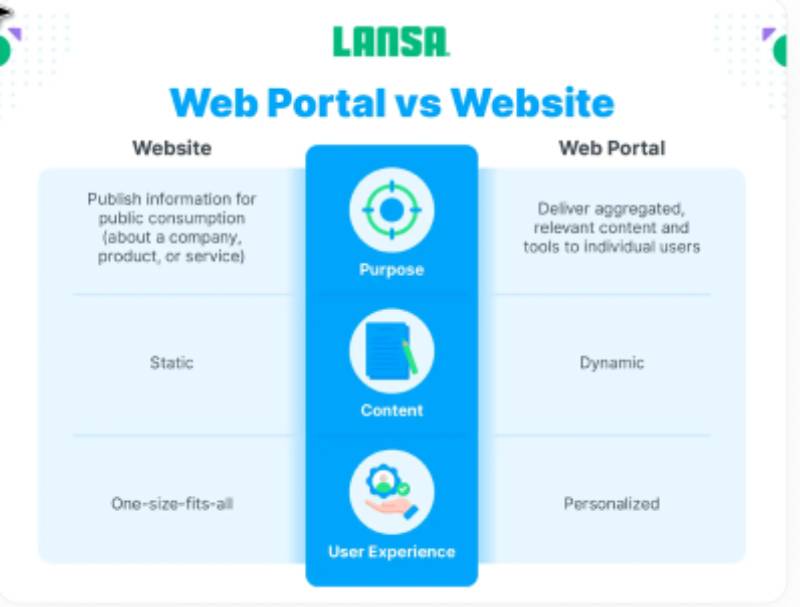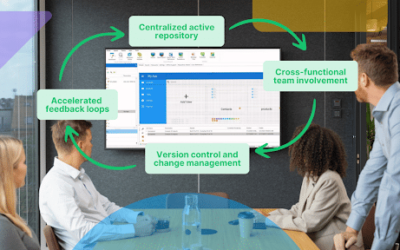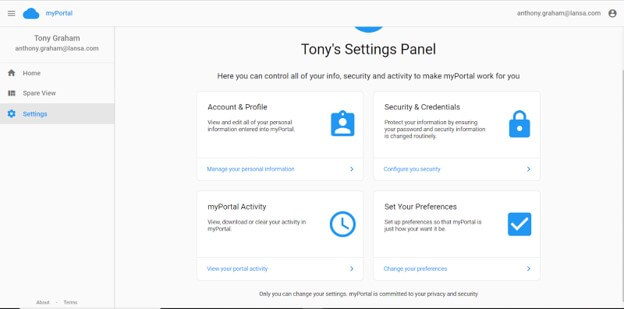Navigating the vast digital landscape can be overwhelming. Web portals act as gateways, streamlining access to critical resources and functionalities and providing a collaborative platform that fosters seamless communication.
Key insights
- Web portals are different from websites. While websites provide general information, web portals offer specific groups of users access to a range of services and data.
- There are many types of web portals, from client and vendor portals to corporate intranets and extranets.
- Portals have evolved. Web portals have evolved from simple platforms to comprehensive portal platforms that support digital customer experiences.
- Web portals offer many benefits. They offer centralized information, personalized experiences, improved collaboration, cost savings, enhanced security, scalability, and accessibility.
What Is a Web Portal?
A web portal is a dynamic and feature-rich web application that serves as a centralized access point for a specific audience. It aggregates information and services from various sources, presenting them in a unified and personalized way. Web portals are important in today’s information-dense environment for several reasons. They combat information overload by acting as a single point of entry. Without a web portal, users would have to manage multiple applications, websites, and logins for different tasks. A portal website also offers personalization. Users can tailor the information and functionalities they see based on their roles, preferences, or past interactions. A web portal also fosters collaboration and communication by providing shared workspaces, discussion forums, and communication tools, allowing teams to work together seamlessly. This is particularly valuable for organizations with geographically dispersed teams or those working on complex projects. A web portal empowers users with increased control and efficiency. They simplify information access, personalize the user experience, and foster collaboration, making them a cornerstone of the modern digital landscape or an IBM i application modernization project. If you’re still uncertain about the web portal’s meaning, the next section will tell you how it differs from a standard website.
“Lorem ipsum dolor sit amet, consectetur adipiscing elit. Fusce gravida quis dui at tempor. Pellentesque habitant morbi tristique senectus et netus et malesuada fames ac turpis egestas. Nunc turpis lacus, aliquam id finibus a, sodales a purus. Nulla vel dignissim risus. Vivamus ligula eros,”
LANSA, Lead Talent Development Partner
Web Portal vs Website: What Is the Difference?
While you may be asking, “What is a portal website?” the definition of a web portal goes beyond “website.” Think of a website as a single building. It serves a specific purpose, offers certain products or information, and caters to a general audience. A web portal, in contrast, is more like a town square. It acts as a central hub, bringing together various resources and functionalities under one roof.
A web portal is a centralized online platform, and here are some of its key differences from a website:
- Purpose: Websites typically serve a singular purpose, such as showcasing a company’s products or providing information about specific topics. A web portal, on the other hand, aggregates information and services from many sources, catering to a more targeted audience with specialized needs.
- Content and functionality:Websites typically offer static content or limited functionalities like contact forms or online brochures. A web portal, however, is a dynamic environment. It can integrate features like personalized dashboards, user profiles, search functionalities, and communication tools.
- User experience:Websites generally offer a one-size-fits-all experience. A web portal, on the other hand, can personalize user experiences by tailoring content and functionalities based on user roles, preferences, or past interactions.
- Security:Security requirements can vary depending on a website’s purpose. A web portal, however, often handles sensitive information and requires robust security measures to ensure user privacy and data protection.
3 Web Portal Types
While the concept of a web portal is broad, there are various types of web portals that cater to specific industries, purposes, and user groups. Here are 10 common types of web portals:
Client Portals
These secure online spaces function as a communication and collaboration hub between companies and their clients. A client portal typically offers features like account management, document sharing, project progress tracking, and support ticket systems.
Vendor Portals
Similar to client portals, vendor portals provide a platform for streamlined communication and collaboration between a company and its vendors or suppliers. A vendor portal can facilitate tasks such as order management, inventory tracking, invoice processing, and communication channels
Education Portals
In the education sector, a web portal acts as a virtual learning environment. An education portal offers students a centralized location to access course materials, submit assignments, take quizzes online, and interact with instructors and classmates. These portals can also provide faculty with tools for managing classes, delivering lectures, and tracking student progress
Evolution of Web Portals
Web portals have undergone a significant transformation since the early days as glorified directories. If you haven’t used a web portal in a while, how you define a web portal might not fit the modern portal definition. An early web portal primarily functioned as an entry point, offering basic functionalities like search engines and links to various websites. They were more like advanced online directories, helpful for navigating the web but lacking the sophistication of today’s offerings. The evolution of the web portal has been driven by the growing need for better user experience, personalization, and functionality. A modern web portal is a comprehensive platform that supports digital customer experiences. Here’s how:
- Advanced features: A modern portal integrates many advanced functionalities. Content Management systems allow for dynamic and up-to-date information delivery while marketing automation tools personalize the user experience by tailoring content and offerings based on user preferences or interactions.
- Mobile support: A modern web portal is optimized for mobile devices, ensuring a seamless user experience regardless of the device used.
- User experience focus: A modern web portal prioritizes user experience by offering intuitive interfaces, personalized dashboards, and interactive elements.
















